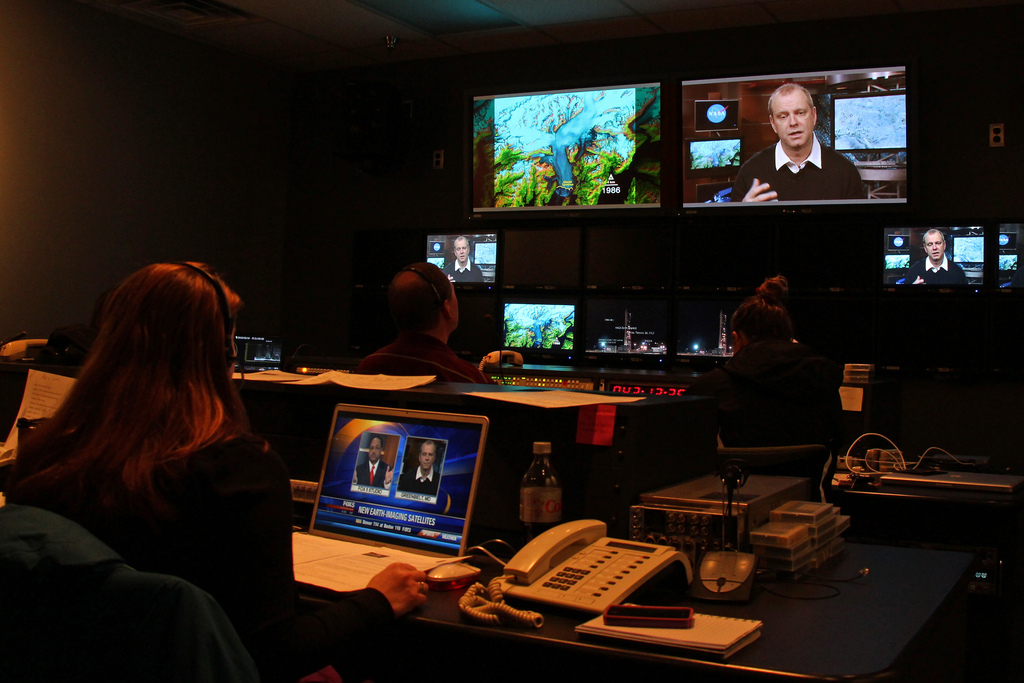
If you’ve spent any time watching news blooper videos on YouTube, you’ve probably seen a wide variety of live shots going wrong. But how you should deal with unexpected events on live television when you graduate and get a job in broadcast journalism?
Live Shots: A Million Ways Things Can Go Wrong
There is no shortage of possible problems you might experience during a live shot. Teenagers sometimes get a kick out of screaming profanity or making obscene hand gestures on live TV. Adult hecklers who don’t like the subject of your story might try to make their opinions heard. People being interviewed can become flustered, have a meltdown, or decide now is the time to launch into a diatribe about a subject unrelated to the story you’re covering. Then there are unexpected weather problems, animals running into shots, etc.
People
Remember that your job is to report the story. Try to ignore hecklers—engaging with them only encourages more heckling. Stay on track with what you’d planned to say. If the heckling gets worse anyway, you may want to wrap up quickly and pitch back to the anchor. If someone is screaming profanity, pitch back to the anchor immediately—chances are, someone in the control room has already killed your mike anyway and didn’t have time to tell you.
Obviously, those working in the control room should also be ready to cut away from a live shot at a moment’s notice if things go wrong. If you’re sitting at the anchor desk, you should be prepared for unexpected problems, as well. If the reporter has a live shot script in the prompter, it’s best to scroll through it with him or her instead of cuing the prompter to your tag—that way, you can finish reading what the reporter planned to say if it becomes necessary. If there isn’t a reporter tag in the prompter, briefly apologize, read the anchor tag, promise to have more on the story later, and move on.
Sometimes people cause problems with live shots unintentionally. Your interviewee might have a sudden attack of nerves upon realizing he or she is on live television and people are watching. You don’t want to look like the heartless reporter who embarrassed someone on TV—and some people might interpret the situation that way, even though the reality is that you don’t control other people’s emotions.
You can, however, try to make things easier on your subjects. If an interviewee seems nervous before the live shot, try to distract them from things like lights and cameras. Make small talk with them. Getting your subjects talking about things that make them happy—their families, pets, hobbies—can help put them at ease.
You may not always have time to talk to the person you’re interviewing before the live shot. If, despite your best efforts, someone gets visibly flustered, starts stammering, or babbling about nothing, help them out. Asking a long-winded question can give interviewees time to collect themselves. You can repeat some facts about the subject of the conversation, and gradually lead back into a question for the subject. Although it’s usually better to ask open-ended questions so you can get more than a one-word answer, if the subject is flustered, you might try lobbing them a few yes/no questions. Having someone nod or stammer, “Mm-hmmm” may not result in the most brilliant interview ever, but it’s better than having the subject clam up completely or walk off in the middle of the interview.
Weather, Animals, And Other Unforeseen Events
Sometimes things just happen beyond your control. The good thing about these kinds of calamities is that they can actually make for great viral videos—meaning more publicity for you and your station—if you handle things well. Try to roll with whatever happens. There’s no need to pretend things didn’t go wrong—acknowledge it and keep going. “Well, as you can see, it’s very windy out here, but that hasn’t stopped the crowd of people who came out for this event….”
Remember, the reporter who laughs off a mishap and continues to report the story will be remembered in a more positive light than one who gets upset and flustered.
Microphones, Cameras, Lights, Technical Difficulties
You’ve probably learned in school that the best way to deal with technical difficulties is to prevent them by planning carefully and checking out your equipment beforehand.
But in the real world, sometimes you just don’t have time, or everyone is busy dealing with one problem and overlooks another. Even with the best preparation, electronics can fail spontaneously.
If you’re a photographer or part of a camera crew, you’ll need to master the art of getting the reporter a new mic without completely distracting him or her. Usually the best bet is just to hand it to them, or wave it in the air just off-camera. At least they’ll have an idea what you want them to do. Random hand gestures, waving frantically, or a producer yelling in the reporter’s IFB (a small earpiece that allows you to hear the off-air signal and sometimes the control room) can result in an inexperienced reporter getting distracted and stumbling through his or her script.
If you’re in front of the camera and think your mike or camera isn’t working, pretend like it is. Just keep reading your script or talking about the story. If your mic suddenly starts working (or someone in the control room remembers to turn it on after all), you don’t want to be complaining about your station’s crummy equipment at the exact moment that happens. You also don’t want to be making a face, rolling your eyes, or looking panicky when they finally get a picture to go with the sound. If the problem can’t be solved, someone in the control room will eventually let you know you’re clear, either by communicating through your IFB or having the photographer tell you.
[su_note]Learn more about the School of Broadcast Journalism at the New York Film Academy by clicking here.[/su_note]